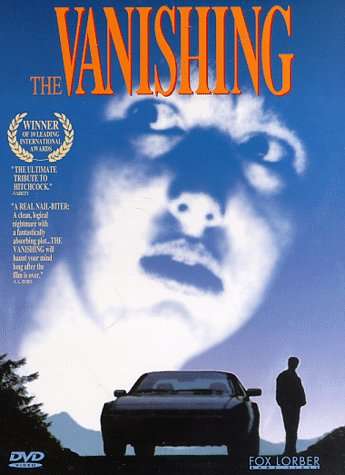The Vanishing

Dutch suspense-thriller directed and co-written by George Sluzier, made in 1988, adapted from the novella The Golden Egg by Tim Krabbé (who also co-wrote the screenplay). It concerns a man named Rex (Gene Bervoets) looking for his missing girlfriend, Saskia (Johanna Ter Steege). He eventually meets Raymond (Bernard-Pierre Donnadieu), the man responsible for her disappearance, who refuses to tell him what happened to her. What is Rex willing to do to find out?
Remade in 1993 (by the same director) with Kiefer Sutherland, Jeff Bridges, Sandra Bullock, and Nancy Travis. The remake was not as well-received as the original.
There was also a BBC radio play version in 2011.
Tropes used in The Vanishing include:
- Adult Fear: Saskia's disappearance
- Affably Evil: Raymond is impossibly charming and polite.
- The Bad Guy Wins
- Black Comedy: Flashes of it here and there. The scene in which Raymond clumsily practices knocking women out with chloroform is very darkly humorous indeed.
- Blue and Orange Morality: In the 1993 remake of the film, the villain character is named Barney, played by Jeff Bridges. His justification for his actions in the remake are that he would feel unworthy of his daughter's love after saving a little girl's life unless he also committed an equal act of evil.
- Buried Alive
- Completely Different Title: The original Dutch title is Spoorloos (roughly "Traceless"). It was released in English-speaking countries as The Vanishing and in France as L'homme qui voulait savoir (The Man Who Wanted to Know).
- Criminal Mind Games
- Downer Ending: Only in the original.
- Fatal Flaw: Rex's obsessive need to know what happened to Saskia, even at the expense of seeking justice for her, ultimately results in him bankrupting himself, destroying his relationship with Lieneke and allowing Rex to kill him.
- Foreign Remake: With an American cast and setting (although the director of the original returned).
- For the Evulz: The villain is an emotional blank slate. The greatest high of his life was when he saved his daughter from drowning. Now he wants to see if he can get a similar high from doing something really evil.
- In the original film, the villain is a science teacher who wants to kill and get away with it because... he just wants to do something different in his life.
- Heroes Want Redheads: Saskia.
- Insane Troll Logic: See Blue and Orange Morality.
- Internal Reveal: The audience knows who the killer is almost immediately, but Rex does not find out until the beginning of the third act.
- Karma Houdini
- Not His Sled: The remake changes the ending.
- Psychological Thriller
- The Remake
- Reverse Whodunnit: Subverted. The audience knows who the killer is from the outset, and Rex eventually learns who he is and how he killed Rex's girlfriend - but the killer gets away with it anyway.
- Revised Ending: In the remake.
- Rule of Symbolism: In the original book, named "Het Gouden Ei" (transl. "The Golden Egg"), the audience is explained that the lead character was having nightmares about being trapped inside a Golden Egg while his significant other is trapped inside another. They could only be released from their eggs if they crashed into each other. The catch? Their eggs are flying through outer space, and not on a direct collision course, so most likely they would never be free. Considering how the book and the original movie end, the symbolism of this dream is quite fitting. The remake not so much.
- Screw Destiny: The villain claims that when he was a teenager he deliberately jumped off the balcony of his apartment just for the sake of doing this. He claims it resulted in him breaking his leg and losing two fingers, although the actor quite obviously still has ten fingers (it's possible he was simply messing with Rex's head, however).
- The Sociopath: Raymond.
This article is issued from Allthetropes. The text is licensed under Creative Commons - Attribution - Sharealike. Additional terms may apply for the media files.